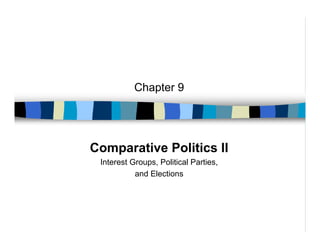
Grigsby slides 9
- 1. Chapter 9 Comparative Politics II Interest Groups, Political Parties, and Elections
- 2. Interest Groups • Any collection of people trying to influence government • Nonpublicly accountable organizations that attempt to promote shared private interests by influencing public-policy outcomes
- 3. Interest Groups Differ from Political Parties • Goals • Parties acquire power through elections • Interest groups focus on specific issues rarely represented in government • Nature of memberships • Parties seek broad support • Interest groups have a narrower membership • Numbers • Rarely more than 10-12 parties • No limit on number of interest groups
- 4. Who Belongs? • Pluralist view - Multiplicity of groups - Varied interests - Optimistic view • Elite view - Majority from middle- and upper-classes - Domination by business-related interests - No organization by lower classes
- 5. Interest Groups and Government • Interest groups presuppose an existing government worth trying to influence. • As government grows, so do interest groups. • Some interest groups take on government functions (corporatism). • The bureaucracy has become one of the biggest and most powerful interest groups of all.
- 6. Big Money • The single most important factor in interest group success • Danger: “the best Congress money can buy.” • Corruption (public office for private gain) • Soft Money • Contributing to parties and interest groups not directly working for a candidate’s election campaign. • “If you don’t give, you get no access.” • U.S. campaigns lengthy and costly
- 7. Political Action Committees (PACs) • Set up specifically to contribute money to election campaigns • Originally an idea of labor unions • Biggest spending from business • Bulk of contributions to incumbents
- 8. Interest Group Strategies • Approaching lawmakers • Approaching the administration • Approaching the judiciary • Appeals to the public • Demonstrations • Violent protest “Violence is as American as cherry pie.” -- Black radical H. “Rap” Brown
- 9. Finding a Balance Good of all vs. Good of particular groups There must be no “particular wills” to muddy and distort the “general will,” that which the whole community wants. -- Jean-Jacques Rousseau
- 10. Political Parties and Party Systems
- 11. Political Party • Group seeking to elect office- holders under a given label Exist in almost all present-day societies, democratic or not Weak in U.S.
- 12. Functions of Parties • Bridge between people and government • Aggregation of interests • Integration into the political system • Political socialization • Mobilization of voters • Organization of government
- 13. Parties in Democracies • Centralization • Degree of control exercised by national headquarters • Setting government policy • Executive must work with legislative • Party participation in government • Financing the party • Dependence on interest groups
- 14. Classifying Parties • Left (liberal) • Center-left • Centrist • Center-right • Right (conservative)
- 15. Party Systems • One-party • Totalitarian • Dominant-party • Opposition parties free to run, but rarely win • Two-party • Multiparty • Two-plus party • Fluid (or inchoate) party • New and unstable democracies
- 16. Parties and Electoral Systems • Single-member election districts • Where a simple plurality wins – Tends to produce two-party or two-party plus systems Proportional representation – Use multimember districts and assign parliamentary seats in proportion to the percentage of votes in that district – Encourages parties to split
- 17. Types of Party Competition • Moderate pluralism • Center-seeking • Parties become moderate, aiming for large block of votes in center of political spectrum Polarized pluralism – Center-fleeing – Parties become extremist, ignoring voters in center – Can cause political unrest and civil war
- 18. Just because you don't take an interest in politics, doesn't mean politics won't take an interest in you! Pericles - 430 BC (BCE) "Regarding Government: We call for the abolition of damn near everything; We call for drastic reductions in what's left; And we refuse to pay for any of it!" Platform synopsis by David Nolan, LP Co-founder
- 19. Elections
- 20. Electoral Systems • Single-Member Districts • Electoral system that elects one person per district • “First past the post” – FPTP • Supports two-party system • Advantages • Inhibits the growth of extremism • Gives clear parliamentary majority to one party • Majoritarian system • Disadvantages • Losing parties get no representation
- 21. Electoral Systems • Proportional Representation • Electoral systems based on multimember districts • Representatives elected by party’s percent of vote • Advantages • Legislature accurately reflects public opinion and party strength • Disadvantages • Often lead to multiparty systems • Greater instability than two-party system
- 22. Voter Turnout • Percent of those eligible who vote • U.S. peak in 1960 – 63% • Sweden, Germany, Italy – 90% U.S. turnout low historically Lower in U.S. than in other democracies
- 23. U.S. Nonvoting: The Debate • Low electoral participation means that many Americans are turning away from the political system. • Or, the decline may mean that Americans are basically satisfied with the system.
- 24. How Do People Vote? • Long-term variables • Party identification • Tendency to associate mentally with one party over may years • Easier to vote along party lines • Important element in electoral stability • Short-term variables • Cause a person to vote one way for one election, but not four years later. • “Morality factor” awakened by Watergate scandal • Economic conditions
- 25. Electoral Alignment • Realignment • Major, long- term shift in party ID. Dealignment – Major, long-term decline in party ID
- 26. What Wins Elections? • Modern elections • Rational choice manipulated by factors of personality and the mass media • “Keep it general, keep it happy, don’t mention parties, and smile a lot.” • Charisma • Retrospective voting • Candidate strategies
- 27. “Democracy: The substitution of election by the incompetent many for appointment by the corrupt few.” -- George Bernard Shaw (1856-1950)